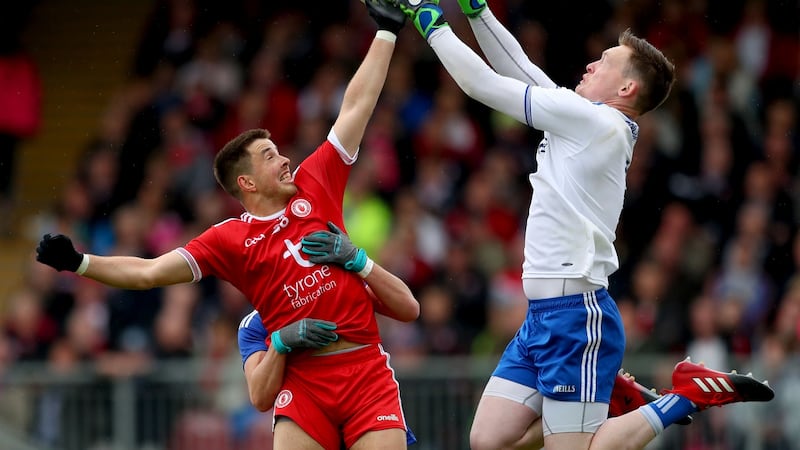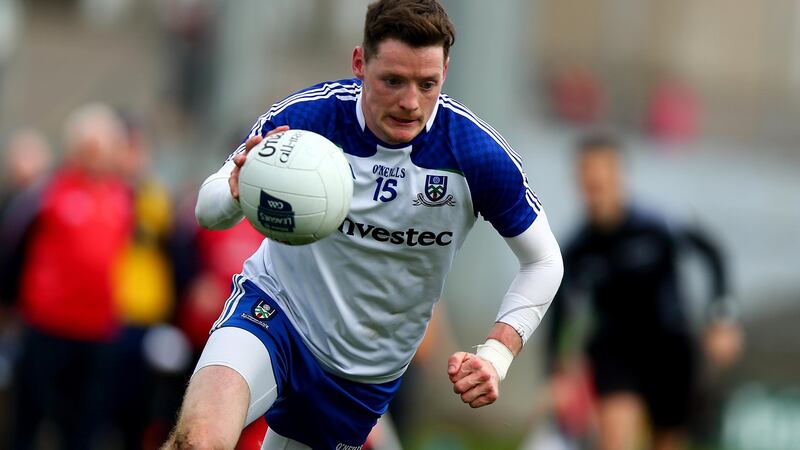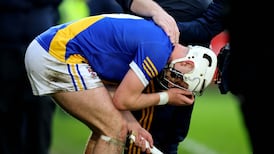For all the talk of the demise of Gaelic football, Monaghan and Tyrone served up a treat on Sunday.
All weekend, my thoughts kept returning to the suspicion that Monaghan were going to win the game. Sometimes you just have that sense about a team. It hinged on a belief that, as a group, they simply had to win this one.
They were put to the sword so many times by Tyrone that they needed, at this stage in their evolution, to go into the lion’s den and stand up and prove themselves to themselves. They had to banish the demons associated with the red and white jersey. In years past, I think the mere sight of that jersey was enough to bother Monaghan. But now they are an experienced team with an impressive group of younger players and I had this feeling they would be ready.
So I headed to Celtic Park to watch Ireland against Celtic in Scott Brown’s testimonial. And my mind kept turning to the game in Omagh. Would they be able to rid themselves of this psychological block they have been stuck on for a long time? I was keeping an eye on them in the league and they have so much going for them.
They have Ulster titles under their belt and now beating Tyrone became a positive drive for them; it was something to chase. So was beating Dublin in Croke Park in the league and they achieved that.
We got back from Celtic Park and, like most people in Ireland, I started following the game on the match tracker and it brought me back to the days of following teams on teletext.
I remember going up to James Boyle’s, a neighbour of mine, to watch Celtic games. He was a mad Celtic fan and he’d be smoking a pipe watching Celtic on Norwegian television! Don’t ask me how he got it but it was one of the few ways you could regularly see Celtic play then. With Norwegian commentary. This, ironically, was at the time when Rangers were dominant in that rivalry and any win for Celtic was a rare occasion.
So I followed the score in Omagh and after the first quarter it was 0-5 to 0-2 to Tyrone. We headed out to Mass, then, and I am sitting there during the sermon and can’t get the game out of my head. I became more and more convinced that Monaghan would find a way. So when I finally sat down to watch it, I knew what the score was at half time but only as far as that.
And I felt it was a really high quality, enjoyable game with high-calibre tactics on show from both management teams. Monaghan’s first score, a point from Fintan Kelly, was a statement of intent, filled with pace and power and directness and it was a sign of what was to come.

Both sides went man to man with plus-one at the back: Donegal, incidentally are doing the same. So it is interesting that all of the leading Ulster teams seem to be going with that tactic. And Dublin basically adopted this system post-2014 so imitation is the highest form of flattery in that the Ulster sides are following that template.
End result
Cathal McShane’s point for Tyrone early on showed the weakness of that system. Tyrone kept moving the ball at pace, keeping it out of contact and waiting for the opportunity to offload to a runner, creating a one-versus-one. Once the individual player beats his man it is basically a straight run on goal. The point is that the defenders need to be extremely tough and aggressive in order for that system to work. If you are in any way loose on a good player, once he gives you the slip, the probability is that a score will be the end result.
And that’s what happened; there was real slickness in attack at both ends and clever angles of running and both sides looked well-schooled. It was clear that both sides were intent on not taking the ball into contact. The spacing was excellent – from both teams.
It was only if a player got into difficulties that the support arrived. They were staying 15 or so metres apart in attack and not crowding the ball. Both sides had options in front and behind them and the option inside to go long and importantly, they each had huge width. You often saw the attacking team with one and sometimes two players on each flank waiting to receive and move the ball. So they were set up to prey on one another’s weaknesses, in a sense.
The systems are identical so both managers knew the vulnerabilities. For instance, you saw Cathal McCarron pushing forward and being dangerous in attack for Tyrone; that brought Conor McManus back. People might ask: why is a player like Conor McManus back in defence? Well, because he was marking his man. The defender was his responsibility.
And as it happened, Conor made two brilliant blocks and had three turnovers in the opening period. But Monaghan varied their attack, too. A point that Jack McCarron scored caught my eye. Monaghan had the ball on the right flank and then moved it sharply to the centre where Darren Hughes injected pace with a run and a quick return pass with his brother.
Then you see Karl O’Connell, who is hugging the sideline, running across the 20. That was something I saw a few times with Monaghan; this 90 degree angle run to the man on the ball. It is a new departure for them and a hard run to mark. And the ball was slipped to Karl and he was chopped down by Frank Burns and it was a handy free for Conor McManus.
It was another example of how much they thought about what they wanted to achieve in how they broke Tyrone down. Go to the 28th minute; a Monaghan kick out and Rory Beggan puts his hands up and it was clear that Niall Kearns was the target at midfield.
Vinnie Corey left the six position and Dessie Ward and Ryan McAnespie flooded the area around the ball. So in the blink of an eye they created a five versus three scenario in the area around the ball. It meant Niall Kearns didn’t even have to win the ball cleanly.
When you move the ball at that pace, the ball will find the solution
And it was just another sign of the work they put in on their timing and squeezing percentages. In the 44th minute Dessie Mone, who had an excellent game, was driving forward with the ball. And simultaneously the Monaghan full forwards ran with aggressive intent away from goal to the 45 while the half-forwards moved the other way. If you watch the movement, it was like synchronised swimming.
Very clinical
So even at 0-5 to 0-2 you could sense that Monaghan were beginning to play on their terms. It became a very even game. Then Monaghan struck with the goal and it was reflective of how they moved the ball all game; sharp and slick and one touch so Tyrone could get no real pressure on the ball.
When you move the ball at that pace, the ball will find the solution. And it didn’t surprise me at all that it was one of senior players who was responsible for that breakthrough. You look at Vinnie Corey and Drew Wylie and these players; they would have been keenly aware that they didn’t want this legacy of losing to Tyrone to continue.
All that said, Tyrone were also very clinical and impressive. They struck seven scores on the trot before they had a wide. Look at Conor McAliskey’s 44th minute point; a strong run with the ball and a sharp score. They were right there, which was no surprise.
And watching it, I was thinking about what Tyrone bring to the table. There is no doubt Tyrone are very highly coached by Mickey Harte. And I remembered watching Armagh games in their pomp at home on television. And you knew almost in advance where the ball would go. If Paul Hearty rubbed his nose on a kick out, the ball went right. They were so well programmed that, in the end, they became predictable. Their strength became their weakness. I think there is a bit of that with Tyrone now.
They have a lot of similar type players in there. They are very smooth on the ball and athletic. But there are no big, unpredictable men like Kieran Hughes or absolute speed merchants like Karl O’Connell.
It seems Monaghan have a few different options that bring a degree of uncertainty as to what they are going to do in attack. With Tyrone, you know what you are going to get so it becomes a question of can you stop it? It’s not to say they lack creativity but their creativity is of a certain type. They do what they do. And that, I believe, became an advantage for Monaghan.
There has been very little talk about burnout with Monaghan and that's because they haven't gone all the way
Peter Harte kicked a point in the 52nd minute and I realised he had been very quiet. And Monaghan maybe had more leaders out there. It’s contradictory. Tyrone were the team going for three-in-a-row but Monaghan were the more experienced team.
Seán Cavanagh is retired and Colm had gone off by the last minutes on Sunday and that takes away from them in terms of senior players. The reality is that Tyrone have managed to win two Ulster championships with youngsters.
Against that you had Dessie Mone, the Wylies, Vinnie Corey, the Hughes; big, physical players with a real presence. It is something that is very valuable in Gaelic football. And they have been on the road a while – all of those guys were there when they won that breakthrough Ulster championship in 2013.
But there has been very little talk about burnout with Monaghan and that’s because they haven’t gone all the way. They were gone a week or so after the Ulster final so there was no sense of them being on the road for ages. And in the years when they exited Ulster early, they tended to go out of the championship pretty quickly also.
Coming together
But I feel there is a coming together within that squad this season, that it is time to right some wrongs of the past. Beating Tyrone – that jersey – was one of those objectives and they have accomplished that now.
With all that said, the game was level with five minutes to go. That was testimony to Tyrone and it suggests to me that they will be a tough nut to crack in the qualifiers.
They could well re-emerge in the Super 8s. It took something special from a special player, Conor McManus, to ultimately win the day. That point close to the sideline was as good as I have seen in the championship.

But it was all of Monaghan’s senior players that had the concluding say in the game and it was those lads claiming a bit of redemption for all the suffering they have had against Tyrone. It was a hugely important victory. They made that painful history become fuel for their experience and drive. On the back of their Dublin win, it pushes them on.
To the world that victory over Dublin was merely a league win. To Monaghan, it was a win in Croke Park; miles apart. Now, they are in a strong place. Malachy O’Rourke was composed afterwards; he played it down. However, they are favourites for Ulster now.
Are they All-Ireland contenders?
The cold truth is that I don’t think they are if they play with that system. I would say the same about Tyrone and Kerry, who set up that way most of the time. Why? Because they are replicating the Dublin system. If you meet Dublin with an identical system, then the team with the best players will prevail. Collectively, that is Dublin.
So you have to do the something different and ask questions. I feel a team like Galway would have a better chance in that they will present Dublin with a challenge they aren’t that used to. Now, maybe Malachy O’Rourke and Mickey Harte and Éamonn Fitzmaurice intend tweaking their system if and when they meet Dublin. And then it becomes a different conversation.
Fermanagh will ask questions of Monaghan because they will be very defensive and tough and they will present a zonal defence. And I expect it to be hard-fought and no classic; one of those games that will further the debate about the future of Gaelic football. It comes down to teams finding the system they feel gives them the best chance of winning.
On Sunday, both Tyrone and Monaghan came in with the same game plan which they executed to a very, very high standard. And Monaghan edged it because the alternative was unthinkable.













